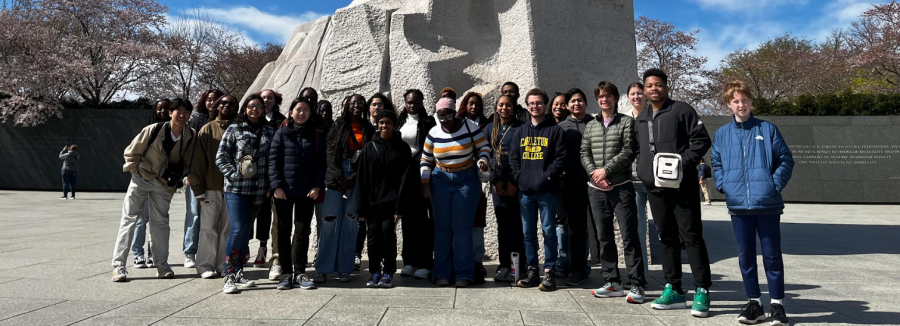After the conclusion of Winter Term, Dean Livingston led 27 students on a spring break trip called “From Northfield to Selma,” which featured stops at important civil rights historical sites in Ohio, Washington, D.C., North Carolina, Georgia, Alabama and Tennessee.
Dean Livingston led this trip for the first time in 2017. The last time it ran was in 2019. Her personal history is part of the inspiration for this trip. Livingston mentioned that “I grew up in the South and experienced firsthand the impact of the civil rights movement. The history of the South is quite complicated and a reflection of current world events.”
While planning the trip, Livingston was aware of and inspired by how much Carleton students value co-curricular experiences that connect to both the classroom and current events. The group visited many museums, whose purpose Livingston described: “The experience . . . highlights the critical role museums play in weaving and preserving the fabric of cultural heritage, and specifically, in constructing civil rights history in the United States.”
Some of the sites visited on the trip included the National Underground Railroad Center in Cincinnati, Ohio; the National Museum of African American History in Washington, D.C.; and the original site of the F.W. Woolworth Company lunchroom counter in Greensboro, North Carolina, among others.
Despite visiting an impressive number of historical sites and museums of the course of the week, Livingston noted that “the highlight of the trip for me is always the time spent with students as we explore history. We save time for reflections, either at dinner or while visiting these museums and spaces. Many of the restaurants we chose had direct connection to the civil rights movement.”
Kaba Shalita ‘24 and Manoka Kozaki ‘26, two of the students that embarked on “From Northfield to Selma,” both had different reasons for choosing to spend their break this way.
On why she chose to go on the trip, Shalita said: “I’ve never been to the South, so I haven’t had the chance to experience firsthand the deep history that is embedded in each of the places we visited. I’m from Minnesota, and the history museums here only scratch the surface when it comes to civil rights history. I wanted a deeper understanding of the civil rights movement.”
Kozaki, who grew up in Japan, said: “I had been somehow feeling the civil rights movement is something not directly relevant to me. However, coming to the U.S. last September, I realized that these histories are still directly connected to today’s American society. For instance, I was surprised that Carleton has some organizations specific for students of color such as OIL. Coming to Northfield, which is close to Minneapolis — where the Black Lives Matter movement occurred — also prompted me to think about these movements as something happening around me. These experiences motivated me to learn more about the civil rights movement in depth, which is why I chose to go on this trip.”
Both Shalita and Kozaki went into the trip hoping to gain a deeper understanding of the civil rights movement and its continuing relevance today and felt that they left having gained even more than they had anticipated.
Shalita said: “It was everything I expected and more. Not only did I learn a lot of new details pertaining to civil rights history, gain a deeper understanding of civil rights history and see new cities, I also connected with my trip mates because of our shared experiences in each of the places we visited. I also got to indulge in so many tasty foods and had a great time during activities outside of visiting museums.”
In a similar vein, Kozaki noted that “I realized that there are many things that we can learn from the history of the civil rights movement that we can apply in today’s society. For example, throughout the trip, we of course learned about some famous historical figures in the civil rights movement, such as Martin Luther King and Rosa Parks. However, we also learned that many African Americans, even including college students, whose names are not as recognized as MLK or other leaders of the movement, also courageously took action against the injustice, even though taking these actions often endangered their lives. I think what we can learn from this is that in achieving social justice, it is important to say no to the things that are not fair and should be changed, even though it is difficult, and to remember that even small powers can make a difference, as it did for the civil rights movement.”
Shalita and Kozaki shared some of the highlights of their trip. Shalita pointed out that the Legacy Museum in Montgomery, Alabama, was her favorite “because of the way it depicted, revealed and honored the untold stories of so many people who have suffered due to injustice.” Kozaki revealed that her favorite museum was the Civil Rights Memorial Center in Montgomery, Alabama, because of a group discussion students had with the curator and other museum staff. Additionally, Kozaki shared that the people were what made this trip so memorable: “One is the people I met on this trip. Throughout the ten days, I had conversations a lot with other Carls whom I never talked to before and made new friends, which I think is one of the nicest things about this trip. We also had opportunities to meet with Carleton alumni in D.C., Georgia and Alabama, and I enjoyed the conversation and asked about their times at Carleton and their careers.”
Overall, “From Northfield to Selma” was an overwhelming success and a positive and educational experience for those who took part.












